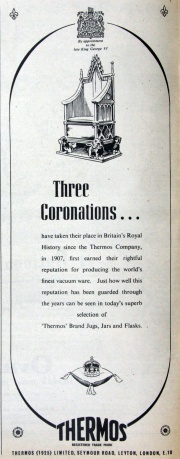


as Thermos Ltd, of 12, 13 and 14 Denman Street, Piccadilly Circus, London, W1. Showrooms and Offices. (1922)
as Thermos (1925) Ltd, of 45 Aldermanbury, London, EC2. Telephone: London Wall 4906. Cables: "Cythermoso, Cent, London". (1929)
as Thermos (1925) Ltd, of Seymour Road, Leyton, London, E10. Telephone: Leytonstone 4061-4. Cables: "Thermos, London". (1947)
1892 Sir James Dewar, a scientist at Oxford University, invented the the "vacuum flask".
1904 It was first manufactured for commercial use, when two German glass blowers formed Thermos GmbH. They held a contest to name the "vacuum flask" and a resident of Munich submitted Thermos, which came from the Greek word Therme meaning "heat".
1907 The Thermos trade mark was sold to three independent companies: 1) The American Thermos Bottle Company; 2) Thermos Ltd - Tottenham, England; 3) Canadian Thermos Bottle Co Ltd.
1911 Thermos made a technological breakthrough - the first machine made glass filler.
1922 British Industries Fair Advert for the Original and Genuine Thermos Products: Flasks; Butter Jars; Jugs; Carafes; Motor Restaurants; Luncheon Cases; Carrying Cases. Keeps hot - 24 hours. Keeps cold 72 hours. (Stand No. K.17) [1]
1923 Gallon insulated food jar - Thermos Jumbo Jug.
1928 and 1929 Ice cream cabinets and frozen fish cabinets - just before refrigeration.
1929 British Industries Fair Advert for vacuum flasks, jugs and various jars. Manufacturers of Thermos "Stronglas" Vacuum Flasks; Thermos Vacuum Jugs; Thermos Vacuum Food Jars; Thermos Vacuum Butter Pots; Thermos Vacuum Ice jars; Thermos Journey Jars.(Glassware Section - Stand No. E.7) [2]
1938 The company moved from Tottenham to a new factory at Leyton.
1939 Break out of World War II - capacity of production in UK changed to wartime requirements.
1945 Thermos brand vacuum bottle was known almost universally for the use with food and beverages.
1947 Listed Exhibitor - British Industries Fair. Manufacturers of Picnic Cases and Travel Requisites. "Thermos" Brand Vacuum Flasks, Jugs and Jars. Liquid Dispensers and Specialities for Aircraft, Railways, Steamships, Hospitals, Hotels. Liquid Air Vessels for laboratories, etc. (Earls Court, 1st Floor, Stand No. 659) [3]
1947 The Leyton factory was enlarged.
1961 The Leyton factory closed when the firm moved to Brentwood.
1971 Thermos products were exported to over 100 different countries and was presented with the Queen of England’s Award to Industry for these export achievements.
1978 A subsidiary of King-Seeley Thermos of USA. Thermos held 70 percent of the UK market for vacuum ware[4]
1978 Saw the introduction of the world’s first Stainless Steel Flask by Thermos, revolutionising hot and cold beverage storage around the world.
See Also
Sources of Information
- ↑ 1922 British Industries Fair Advert ccvi; and p78
- ↑ 1929 British Industries Fair Advert 64; and p165
- ↑ 1947 British Industries Fair p274
- ↑ The Times, Oct 10, 1978











